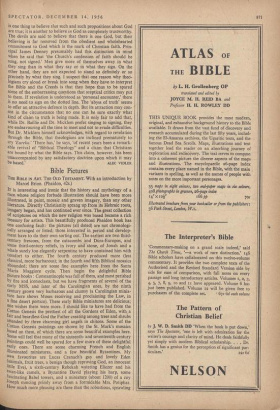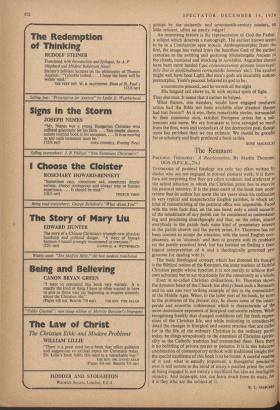Bible Pictures
THE BIBLE IN ART. THE OLD TESTAMENT. With an introduction by Marcel Brion. (Phaidon, 42s.)
Ir is interesting and ironic that the history and mythology of a race whose religion forbade illustration should have been more illustrated, in paint, mosaic and graven imagery, than any other literature. Directly Christianity sprang up from its Hebraic roots, Imagery began, and has continued ever since. The great collection of scriptures on which the new religion was based became a rich treasury for artists. This beautifully produced Phaidon book has one confusing fault : the pictures (all dated) are not chronologi- cally arranged or listed; those interested in period and develop- ment have to do their own sorting out. The earliest are two third- century frescoes, from the catacombs and Dura-Europos, and some third-century reliefs, in ivory and stone, of Jonah and a Whale surely too elegantly serpentine to have contained him with comfort to either. The fourth century produced more (less classical, more barbarous); in the fourth and fifth Biblical mosaics abounded; there are some fine examples here from the Santa Maria Maggiore cycle. Then begin the delightful Bible Picture books : Constantinople was full of them, and most perished by fire and iconoclasts, but we have fragments of several of the early MSS, and later of the Carolingian ones, by the ninth century grown very barbarous and clumsy (a Carolingian minia- ture here shows Moses receiving and proclaiming the Law, in a fine desert portico). These early Bible miniatures are delicious; one wishes there were more. I should like to have had from the Cotton Genesis the prettiest of all the Gardens of Eden, with a fair and beardless God the Father creating among trees and shrubs attended by three charming girl angels in chitons. Some of the Cotton Genesis paintings are shown by the St. Mark's mosaics based on them, of which there are some beautiful examples here. Some will feel that many of the sixteenth- and seventeenth-century Paintings could well be spared for a few more of these delightful early ones. There are some charming French and English illuminated miniatures, and a few beautiful Byzantines. My Own favourites are Lucas Cranach's gay and lovely Eden (animals, fruit trees, a benign though reproving God, an innocent little Eve), a sixth-century Rebekah watering Eliezer and his swan-like camels, a Byzantine David playing his harp, some fascinating Babel towers, and a miniature (about 1200) of a coy Joseph mincing primly away from a formidable Mrs. Potiphar. Row much more pleasing are these than the robustious, sprawling
groups by the sixteenth- and seventeenth-century masters, so little reticent, often so nearly vulgar!
An interesting feature is the representation of God the Father, a subject which deserves a monograph. The earliest known seems to be in a Constantine apse mosaic. Anthropomorphic from the first, the image has varied from the beardless God of the earliest centuries to the swirling and gesturing Michelangelo Ancient in the clouds, maniacal and shocking in terribilita. Augustine should have been more heeded ('qui conuntaaverunt gloriam incorrupti- bilis Dei in similitudinem corruptibilis hominis' etc.). The symbol might well have been Light. But man's gods are incurably anthro- pormorphic. Yeats's peacock believed its god to be :
a monstrous peacock, and he waveth all the night
His languid tail above us, lit with myriad spots of light. Thus also man. It seems that it cannot be helped.
What themes, one wonders, would have engaged medieval artists had the Bible not been available after classical themes had lost favour? As it was, these remarkable stories, surrounded by their numinous aura, satisfied European artists for a mil- lennium and more. We are fortunate to have salvaged so much from the fires, wars and iconoclasts of the destructive past, though more has perished than we can estimate. We should be grateful for so scholarly and finely produced a book as this.
ROSE MACAULAY











































 Previous page
Previous page